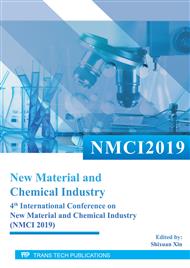[1]
N. M. B. Smeets, S. Imbrogno, S. Bloemberge. Carbohydrate functionalized hybrid latex particles, Carbohydrate Polymers, 173, (2017), 233.
DOI: 10.1016/j.carbpol.2017.05.075
Google Scholar
[2]
X. Ma, R. Jian, P. R. Chang, J. Yu,. Fabrication and characterization of citric acid-modified starch nanoparticles/plasticized-starch composites, Bio macromolecules, 9, (2008),3314.
DOI: 10.1021/bm800987c
Google Scholar
[3]
J. Y. Kim, S. T. Lim. Preparation of nano-sized starch particles by complex formation with n-butanol, Carbohydrate Polymers, 76, (2009), 110-116.
DOI: 10.1016/j.carbpol.2008.09.030
Google Scholar
[4]
D. Liu, Q. Wu, H. Chen, P. R. Chang. Transitional properties of starch colloid with particle size reduction from micro-to nanometer, J. Colloid Interface Sci, 339, (2009), 117.
DOI: 10.1016/j.jcis.2009.07.035
Google Scholar
[5]
Kh. M. Mostafa, H.A.M. Ameen, M. Morsy, A. El-Ebissy, M. Adel, A. Salah. Harnessing of non-fibrous textile for production of high performance easy-care cotton fabrics, Pigment and Resin Technology, 48, 2, (2019), 156–168.
DOI: 10.1108/prt-12-2017-0101
Google Scholar
[6]
N. Lin, J. Huang, P. R. Chang, L. Feng, J.Yu. Effect of polysaccharide nanocrystals on structure, properties, and drug release kinetics of alginate-based microspheres, Colloids Surf. B 85, (2011), 270.
DOI: 10.1016/j.colsurfb.2011.02.039
Google Scholar
[7]
A. Bodin, H. Backdahl, B. Risberg, P. Gatenholm. Nano cellulose as a scaffold for tissue engineered blood vessels, Tissue Eng. 13, (2007), 885.
Google Scholar
[8]
Kh. M. Mostafa, H.A.M. Ameen, M. Morsy, A. El-Ebissy, M. Adel, A. Salah. Production of high-performance textiles via pioneering strengthening approach using starch nanoparticles,Journal of Industrial textiles, In press.
DOI: 10.1177/1528083719827365
Google Scholar
[9]
KH. Young, Park S. S, S.T. Lim. Preparation, characterization and utilization of starch nanoparticles. Colloids Surf B 126, (2015), 607–620.
Google Scholar
[10]
A. Srivastava1 and R. Kumar. Synthesis and Characterization of AcrylicAcid-g-(α-Carrageenan) Copolymer and Study of Its Application, International Journal of Carbohydrate Chemistry, 2013, (2013), 1-8.
Google Scholar
[11]
Kh. M. Mostafa, H. A. El-Meged, M. S. Morsy, A. El- ebasiy and A. A. Elsanabary. Structural Modification of Starch Nanoparticles via Graft Copolymerization Using KMnO4, HCIO4 and HNO3 redox pair, Journal of Polymer and the Environment, 27, (2019), 996-1006.
DOI: 10.1007/s10924-019-01402-5
Google Scholar
[12]
Jaime C. Cazotti, Alexander T. Fritz, Omar Garcia-Valdez, Niels M. B. Smeets, Marc A. Dubé, and Michael F. Cunningham. Grafting from Starch Nanoparticles with Synthetic Polymers via Nitroxide-Mediated Polymerization, Macromol. Rapid Communications. (2019), 1800834.
DOI: 10.1002/marc.201800834
Google Scholar
[13]
M. Labet, W. Thielemans, A. Dufresne. Polymer Grafting onto Starch Nanocrystals, Biomacromolecules, 2007, 8, (2007), 2916-2927.
DOI: 10.1021/bm700468f
Google Scholar
[14]
S. Song, C. Pan Z Wang, X .Wang. Preparation and characterization of amphiphilic starch nanocrystals, J Appl Polym Sci., 107(1), (2008), 418–422.
DOI: 10.1002/app.27076
Google Scholar
[15]
H. Namazi, A. Dadkhah. Convenient method for preparation of hydrophobically modified starch nanocrystals with using fatty acids, Carbohydr Polym 79(3), (2010), 731–737.
DOI: 10.1016/j.carbpol.2009.09.033
Google Scholar
[16]
XF. Ma, RJ. Jian, PR. Chang, JG. Yu. Fabrication and characterization of citric acid-modified starch nanoparticles/plasticizedstarch composites, Biomacromolecules, 9(11), (2008), 3314–3320.
DOI: 10.1021/bm800987c
Google Scholar
[17]
S. Alila, F. Aloulou, W. Thielemans, S. Boufi. Sorption potential of modified nanocrystals for the removal of aromatic organic pollutant from aqueous solution, Ind Crops Prod 33, (2011), 350–357.
DOI: 10.1016/j.indcrop.2010.11.010
Google Scholar
[18]
Kh. M. Mostafa, E. Osman, R. I. Mahmoud and A. A. El-Sanabary.Towards Synthesis and Characterization of Smart Materials Based on Chitosan Using Mn-IV Itaconic Acid as A Novel Redox Pair, Journal of Polymers and the Environment; 26, (2018) 3250–3261.
DOI: 10.1007/s10924-018-1209-4
Google Scholar
[19]
S. Ungeheuer, H. W. Bewersdorff, and R. P. Singh, Turbulent drag effectiveness and shear stability of xanthan-gum-based graft copolymers, Journal of Applied Polymer Science, vol. 37, no. 10, (1989), 2933–2948.
DOI: 10.1002/app.1989.070371012
Google Scholar
[20]
J. K. Seaman, Locust bean gum,, in Handbook of Water Soluble Gums and Resins, R. L. Davidson, Ed., p.6–9, McGraw-Hill, New York, NY, USA, (1980).
Google Scholar


